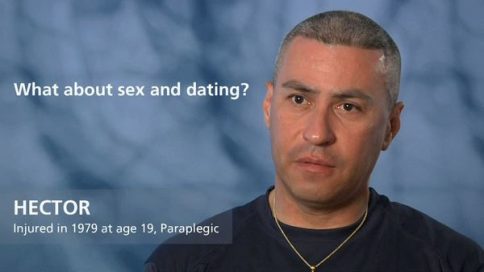What are the common treatments for erectile dysfunction in men with spinal cord injuries? - Diane M. Rowles, MS, NP
|
|
What are the common treatments for erectile dysfunction in men with spinal cord injuries? |
|
Diane M. Rowles, MS, NPNurse Practitioner, Spinal Cord Injury Rehabilitation Program, Rehabilitation Institute of Chicago |
||
| Read Bio | More Videos by Diane M. Rowles | |
|
Share |
||
Transcript
Right now there are about five options available to help with erectile dysfunction. First easiest, what you see on the TV the most is the oral medications, the oral stimulants. The good news is those oral medications work in about 80-percent of men with spinal cord injury, which is wonderful, very, very high. A lot of urologists will say, “Well then you don’t have a problem with erectile dysfunction,” because 80-percent is probably higher than the general population. The second option, which is also a first line, is the vacuum tube turnescense or the vacuum pump. Clear plastic tube, 14-inches long, and it’s purely mechanical, non-invasive, not medications, doesn’t interact with anything. But what you do is put it over the penis, suck the air out, pulls the blood into the penis, pulls into an erection, and then put a constriction band down around the base of the penis, and that holds the penis erect. The third option is injections. Usually, I prefer to use those when the two first options don’t work, or when one of the first options doesn’t work and the person doesn’t want to use the other option. But it’s usually my second line of treatment, is the injections. And that’s of a mediation called Alprostadil and it is injected directly into the sides of the penis into what’s called the corpus, which is the two tubes that go down along either side of the penis. First I want to say it’s a teeny-tiny needle, because if you think about injecting into the penis, everyone’s eyes get really big and everyone takes a big, deep breath, which is understandable. It’s a teeny-tiny needle; I even have men who have sensation, who say that this is painless, okay. But the injection, it goes into the side of the penis and it works very, very well. It works essentially in everyone up to the right dose—there’s a handful of people it doesn’t work in, but it’s actually very responsive. The fourth option is one that is out there, it’s called muse, M-U-S-E. It’s Alprostadil, it’s the same medicine as the injections, but it’s a urethral suppository. And when it came out, it was when we only had the injections and maybe the pump, and we were all excited because we thought, “Oh good, we’re not going to have to use injections any more.” Well time has shown in the spinal cord world, that it doesn’t work very well with men who catheterize. The way it’s intended to be used is right after a man voids, put the urethral suppository in, rub the penis, and it melts and it’s absorbed, and then the smooth muscle relaxes and the blood engorges the penis. So we thought well, when you catheterize there’s probably not enough lubricant in there, so there was lubrication—and when I say “we” I don’t me, I mean the spinal cord world—but lubrication didn’t seem to help. So thoughts now are maybe that if somebody is catheterizing repeatedly, or there’s a catheter in, there’s probably microscopic adhesions along the urethra and the medicine just not absorbed well. So Muse tends to work really well for men who can void on their own, does not tend to work well with men who catheterize. So why do I bring it up?—because I think people need to know about it, because if they read about it on the Internet, or somewhere else, they need to know, “Well is this something for me or not.” The fifth option are penile implants. And they’re out there, they’re a surgical intervention that urologists generally do where a mechanical device is surgically implanted into the penis and it is a penile prosthesis. The complication rate of men with spinal cord injury with penile prosthesis is about 11-12 percent, in the general population it’s one percent. So the risk is higher—and the other thing to remember is that spinal cord injury happens to younger people, and so knowing that all mechanical devices have a life span of a mechanical device, it may not be as long as the lifespan of a person with the spinal cord injury. So you have to consider whether you would do multiple surgeries in that area or not. And the risk of multiple surgeries in that area, the development of scar tissue. So my personal preference, and this is, you can talk to six people and they may say something different, but my personal preference is to see if anything else works and use the penlie prosthesis as absolute last resort, and really, I have a hard time considering it for men who are real young.
Show Less|
|
||
add
What are the common treatments for erectile dysfunction in men with spinal cord injuries? |
||
Diane M. Rowles, MS, NPNurse Practitioner, Spinal Cord Injury Rehabilitation Program, Rehabilitation Institute of Chicago |
More Videos by Diane M. Rowles | |
| Transcriptadd | share | |
Right now there are about five options available to help with erectile dysfunction. First easiest, what you see on the TV the most is the oral medications, the oral stimulants. The good news is those oral medications work in about 80-percent of men with spinal cord injury, which is wonderful, very, very high. A lot of urologists will say, “Well then you don’t have a problem with erectile dysfunction,” because 80-percent is probably higher than the general population. The second option, which is also a first line, is the vacuum tube turnescense or the vacuum pump. Clear plastic tube, 14-inches long, and it’s purely mechanical, non-invasive, not medications, doesn’t interact with anything. But what you do is put it over the penis, suck the air out, pulls the blood into the penis, pulls into an erection, and then put a constriction band down around the base of the penis, and that holds the penis erect. The third option is injections. Usually, I prefer to use those when the two first options don’t work, or when one of the first options doesn’t work and the person doesn’t want to use the other option. But it’s usually my second line of treatment, is the injections. And that’s of a mediation called Alprostadil and it is injected directly into the sides of the penis into what’s called the corpus, which is the two tubes that go down along either side of the penis. First I want to say it’s a teeny-tiny needle, because if you think about injecting into the penis, everyone’s eyes get really big and everyone takes a big, deep breath, which is understandable. It’s a teeny-tiny needle; I even have men who have sensation, who say that this is painless, okay. But the injection, it goes into the side of the penis and it works very, very well. It works essentially in everyone up to the right dose—there’s a handful of people it doesn’t work in, but it’s actually very responsive. The fourth option is one that is out there, it’s called muse, M-U-S-E. It’s Alprostadil, it’s the same medicine as the injections, but it’s a urethral suppository. And when it came out, it was when we only had the injections and maybe the pump, and we were all excited because we thought, “Oh good, we’re not going to have to use injections any more.” Well time has shown in the spinal cord world, that it doesn’t work very well with men who catheterize. The way it’s intended to be used is right after a man voids, put the urethral suppository in, rub the penis, and it melts and it’s absorbed, and then the smooth muscle relaxes and the blood engorges the penis. So we thought well, when you catheterize there’s probably not enough lubricant in there, so there was lubrication—and when I say “we” I don’t me, I mean the spinal cord world—but lubrication didn’t seem to help. So thoughts now are maybe that if somebody is catheterizing repeatedly, or there’s a catheter in, there’s probably microscopic adhesions along the urethra and the medicine just not absorbed well. So Muse tends to work really well for men who can void on their own, does not tend to work well with men who catheterize. So why do I bring it up?—because I think people need to know about it, because if they read about it on the Internet, or somewhere else, they need to know, “Well is this something for me or not.” The fifth option are penile implants. And they’re out there, they’re a surgical intervention that urologists generally do where a mechanical device is surgically implanted into the penis and it is a penile prosthesis. The complication rate of men with spinal cord injury with penile prosthesis is about 11-12 percent, in the general population it’s one percent. So the risk is higher—and the other thing to remember is that spinal cord injury happens to younger people, and so knowing that all mechanical devices have a life span of a mechanical device, it may not be as long as the lifespan of a person with the spinal cord injury. So you have to consider whether you would do multiple surgeries in that area or not. And the risk of multiple surgeries in that area, the development of scar tissue. So my personal preference, and this is, you can talk to six people and they may say something different, but my personal preference is to see if anything else works and use the penlie prosthesis as absolute last resort, and really, I have a hard time considering it for men who are real young.

































